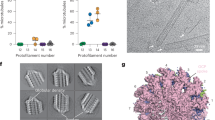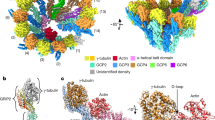Abstract
Microtubules are hollow polymers of αβ-tubulin that show GTP-dependent assembly dynamics and comprise a critical part of the eukaryotic cytoskeleton. Initiation of new microtubules in vivo requires γ-tubulin, organized as an oligomer within the 2.2-MDa γ-tubulin ring complex (γ-TuRC) of higher eukaryotes1,2,3. Structural insight is lacking regarding γ-tubulin, its oligomerization and how it promotes microtubule assembly. Here we report the 2.7-Å crystal structure of human γ-tubulin bound to GTP-γS (a non-hydrolysable GTP analogue). We observe a ‘curved’ conformation for γ-tubulin–GTPγS, similar to that seen for GDP-bound, unpolymerized αβ-tubulin4. Tubulins are thought to represent a distinct class of GTP-binding proteins, and conformational switching in γ-tubulin might differ from the nucleotide-dependent switching of signalling GTPases. A crystal packing interaction replicates the lateral contacts between α- and β-tubulins in the microtubule5, and this association probably forms the basis for γ-tubulin oligomerization within the γ-TuRC. Laterally associated γ-tubulins in the γ-TuRC might promote microtubule nucleation by providing a template that enhances the intrinsically weak lateral interaction between αβ-tubulin heterodimers. Because they are dimeric, αβ-tubulins cannot form microtubule-like lateral associations in the curved conformation5. The lateral array of γ-tubulins we observe in the crystal reveals a unique functional property of a monomeric tubulin.
This is a preview of subscription content, access via your institution
Access options
Subscribe to this journal
Receive 51 print issues and online access
$199.00 per year
only $3.90 per issue
Buy this article
- Purchase on Springer Link
- Instant access to full article PDF
Prices may be subject to local taxes which are calculated during checkout



Similar content being viewed by others
References
Stearns, T. & Kirschner, M. In vitro reconstitution of centrosome assembly and function: the central role of γ-tubulin. Cell 76, 623–637 (1994)
Zheng, Y. et al. Nucleation of microtubule assembly by a γ-tubulin-containing ring complex. Nature 378, 578–583 (1995)
Moritz, M. et al. Recruitment of the γ-tubulin ring complex to Drosophila salt-stripped centrosome scaffolds. J. Cell Biol. 142, 775–786 (1998)
Ravelli, R. B. G. et al. Insight into tubulin regulation from a complex with colchicine and a stathmin-like domain. Nature 378, 198–202 (2004)
Li, H. et al. Microtubule structure at 8 Å resolution. Structure (Camb.) 10, 1317–1328 (2002)
Lowe, J. et al. Refined structure of αβ-tubulin at 3.5 Å resolution. J. Mol. Biol. 313, 1045–1057 (2001)
Nogales, E., Wolf, S. G. & Downing, K. H. Structure of the αβ tubulin dimer by electron crystallography. Nature 391, 199–203 (1998)
Nogales, E. et al. Tubulin and FtsZ form a distinct class of GTPases. Nature Struct. Biol. 5, 451–458 (1998)
Oliva, M. A., Cordell, S. C. & Lowe, J. Structural insights into FtsZ protofilament formation. Nature Struct. Mol. Biol. 11, 1243–1250 (2004)
Chretien, D., Fuller, S. D. & Karsenti, E. Structure of growing microtubule ends: two-dimensional sheets close into tubes at variable rates. J. Cell Biol. 129, 1311–1328 (1995)
Keating, T. J. et al. Microtubule release from the centrosome. Proc. Natl Acad. Sci. USA 94, 5078–5083 (1997)
Otwinowski, Z. & Minor, W. in Methods in Enzymology: Macromolecular Crystallography, Part A (eds Carter, C. W. & Sweet, R. M.) 307–326 (Academic, New York, 1997)
Brunger, A. T. et al. Crystallography & NMR system: A new software suite for macromolecular structure determination. Acta Crystallogr. D Biol. Crystallogr. 54, 905–921 (1998)
Jones, T. A. et al. Improved methods for building protein models in electron density maps and the location of errors in these models. Acta Crystallogr. A 47, 110–119 (1991)
Delano, W. L. The PyMOL Molecular Graphics System (DeLano Scientific, San Carlos, California, 2002)
Acknowledgements
We thank S. Murphy for protein purification advice early in the project, the Mullins laboratory for the use of their ultraviolet illuminator, and the Agard laboratory centrosome group for discussions and input. We acknowledge the support of this work by grants from the National Institutes of Health (D.A.A. and T.S.) and the Howard Hughes Medical Institute. H.A. acknowledges support from an NIGMS predoctoral fellowship, and L.M.R. was a Paul Sigler/Agouron Institute fellow of the Helen Hay Whitney Foundation. D.A.A. is a Howard Hughes Medical Institute Investigator.
Author information
Authors and Affiliations
Corresponding author
Ethics declarations
Competing interests
Coordinates and structure factors have been deposited in the Protein Data Bank under accession numbers 1Z5V and 1Z5W. Reprints and permissions information is available at npg.nature.com/reprintsandpermissions. The authors declare no competing financial interests.
Supplementary information
Supplementary Methods
Methods used, including protein preparation and nucleotide binding experiments. (DOC 30 kb)
Supplementary Figure Legends
Legends for Supplementary Figures S1 and S2. (DOC 22 kb)
Supplementary Figure S1
Unique surface features of γ-tubulin. (PPT 1185 kb)
Supplementary Figure S2
Structural comparisons between the γ-tubulin structure and the curved and straight γ-tubulin structures. (PPT 1951 kb)
Rights and permissions
About this article
Cite this article
Aldaz, H., Rice, L., Stearns, T. et al. Insights into microtubule nucleation from the crystal structure of human γ-tubulin. Nature 435, 523–527 (2005). https://doi.org/10.1038/nature03586
Received:
Accepted:
Issue Date:
DOI: https://doi.org/10.1038/nature03586
This article is cited by
-
Reconstitution of microtubule into GTP-responsive nanocapsules
Nature Communications (2022)
-
Regulation of microtubule dynamics, mechanics and function through the growing tip
Nature Reviews Molecular Cell Biology (2021)
-
Targeting the cytoskeleton against metastatic dissemination
Cancer and Metastasis Reviews (2021)
-
Case reports: novel TUBG1 mutations with milder neurodevelopmental presentations
BMC Medical Genetics (2019)
-
Tubulinopathies continued: refining the phenotypic spectrum associated with variants in TUBG1
European Journal of Human Genetics (2018)
Comments
By submitting a comment you agree to abide by our Terms and Community Guidelines. If you find something abusive or that does not comply with our terms or guidelines please flag it as inappropriate.



